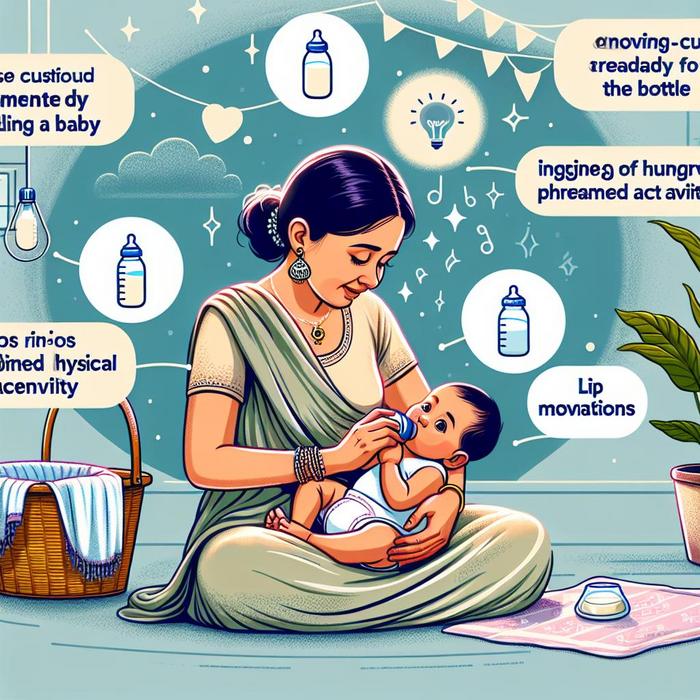Identifying the Correct Time for Bottle Introduction
Introducing your baby to a bottle is indeed a significant milestone, yet it can be a daunting task. Parents often ponder about the ‘when’ and ‘how’ of it. Among the most commonly asked questions is, “How do I know my baby is ready for a bottle?” With a few signs and indications, you can ably discern this. Let’s delve into understanding baby bottle readiness.
Recognizing Bottle Readiness
Recognizing whether your baby is ready for bottle feeding is essential for a smooth transition. Each baby is different; consequently, these signs might differ as well. However, some common indicators suggest that your baby might be ready for a bottle.
- Reduced Rooting Reflex: Rooting is a newborn reflex where a baby turns its head towards anything that strokes its cheek or mouth. As your baby grows older, this reflex gradually disappears often indicating that they may be ready for a bottle.
- Weight Gain: Steady weight gain is often a good sign that your baby is ready for bottle feeding. It shows they are getting enough nutrition and are ready for a diverse feeding source.
- Increased Alertness: If your baby seems more alert and curious, showing interest in your eating habits, chances are, they are ready for the bottle.
Understanding these signs can be beneficial. MedicineNet provides a comprehensive guide on signs to look for when deciding to wean your baby from breastfeeding.
Transitioning from Breastfeeding to Bottle Feeding
Once you have perceived your baby is ready for a bottle, the next step is to make the transition from breast to bottle feeding. This transition should be as gentle as possible for your little one. Here are a few steps to help you navigate this journey:
- Choosing the Right Bottle: When introducing bottle feeding, the right bottle can make a great difference. Choose a slow-flow bottle initially to mimic the natural rhythm of breastfeeding. You can find an array of options at biomimetic-feeding.com.
- Gradual Introduction: Start by replacing one breastfeeding session with a bottle feed. Increase the number gradually. Biomimetic-feeding.com has handy tips for achieving a successful breastfeeding and bottle feeding balance.
- Checking Flow Rate: Ensure the milk flow rate is appropriate for your child. The flow rate should not cause choking or irritate the child. Nationwide Children’s provides a detailed guide for choosing the proper bottle flow rate.
Remember, all babies are unique and your baby might show readiness for a bottle in their own time. Be patient and attentive to their needs, and the transition will happen smoothly.
Establishing a Bottle Feeding Routine
Establishing a proper routine is crucial to maintaining your baby’s health and growth. Having a feeding schedule can assist your baby in establishing and maintaining regular sleeping and feeding patterns. Here’s how to go about it:
- Regular Feeding: Infants need regular feeding. Experts suggest that newborns should be fed every 2-3 hours.
- Respond to Hunger Cues: While having a feeding schedule is beneficial, it’s also essential to respond to your baby’s hunger cues. If your baby appears hungry before the next scheduled feeding, consider feed them sooner. This article from the CDC explains signs your child may be hungry or full.
- Monitor Quantity: The amount of milk your baby consumes is important. On average, a newborn should consume about 1.5 to 3 ounces of milk per feeding session.
Progressing to Holding the Bottle
Another significant milestone in the baby’s development is when they begin to hold their bottle. So, when do babies hold their own bottle? It usually happens between 6 to 10 months, but each baby may reach this stage at their own time. Here are a few signs to identify if your baby is ready to hold their bottle:
- Improved Hand-Eye Coordination: Watch your baby’s hand-eye coordination develop. If they’re reaching out for objects more precisely, they might be ready to hold their own bottle.
- Increased Grip Strength: As your baby develops physically, their grip strength will also increase. If they’re grasping onto objects firmly, it’s a sign that they could start holding their own bottle.
- Interest in Feeding Themselves: Spot whether your baby has an interest in feeding themselves. If they often try to grab their bottle during feeding, your baby could be ready to do it on their own.
To explore this topic further, check out this useful article from Healthline.
Weaning Off the Bottle
Another significant stage is weaning your baby off the bottle, which typically occurs at around the age of 12 months. The transition from bottle to cup feeding is a milestone that fosters your child’s independence and promotes healthy drinking habits. Here are some steps to help you through the process:
- Gradual Weaning: Try gradually reducing the number of bottle feedings each day, replacing them with cup feedings.
- Use Distractions: Distracting your baby with other activities during their normal bottle-feeding times can make the transition easier.
- Be Consistent: Consistency is key. Ensure your baby gets used to their new routine by sticking to it.
To learn more about this process, view KidsHealth‘s comprehensive guide on weaning your baby off the bottle.
Integrating a bottle into your baby’s feeding routine is an important step not just for their development, but also for giving mothers a break and allowing other family members to bond with the baby. However, remember that every child is unique and might not adhere to this universal pattern—patience and awareness to your baby’s signals are key.

